Topics
Mathematical Reasoning
- Mathematically Acceptable Statements
- New Statements from Old
- Special Words Or Phrases
- Contrapositive and Converse
- Introduction of Validating Statements
- Validation by Contradiction
- Difference Between Contradiction, Converse and Contrapositive
- Consolidating the Understanding
Sets
- Sets and Their Representations
- Empty Set (Null or Void Set)
- Finite and Infinite Sets
- Equal Sets
- Subsets
- Power Set
- Universal Set
- Venn Diagrams
- Intrdouction of Operations on Sets
- Union of Sets
- Intersection of Sets
- Difference of Sets
- Complement of a Set
- Practical Problems on Union and Intersection of Two Sets
- Proper and Improper Subset
- Open and Close Intervals
- Disjoint Sets
- Element Count Set
Sets and Functions
Relations and Functions
- Cartesian Product of Sets
- Concept of Relation
- Concept of Functions
- Some Functions and Their Graphs
- Algebra of Real Functions
- Ordered Pairs
- Equality of Ordered Pairs
- Pictorial Diagrams
- Graph of Function
- Pictorial Representation of a Function
- Exponential Function
- Logarithmic Functions
- Brief Review of Cartesian System of Rectanglar Co-ordinates
Algebra
Trigonometric Functions
- Concept of Angle
- Introduction of Trigonometric Functions
- Signs of Trigonometric Functions
- Domain and Range of Trigonometric Functions
- Trigonometric Functions of Sum and Difference of Two Angles
- Trigonometric Equations
- Trigonometric Functions
- Truth of the Identity
- Negative Function Or Trigonometric Functions of Negative Angles
- 90 Degree Plusminus X Function
- Conversion from One Measure to Another
- 180 Degree Plusminus X Function
- 2X Function
- 3X Function
- Expressing Sin (X±Y) and Cos (X±Y) in Terms of Sinx, Siny, Cosx and Cosy and Their Simple Applications
- Graphs of Trigonometric Functions
- Transformation Formulae
- Values of Trigonometric Functions at Multiples and Submultiples of an Angle
- Sine and Cosine Formulae and Their Applications
Coordinate Geometry
Complex Numbers and Quadratic Equations
- Concept of Complex Numbers
- Algebraic Operations of Complex Numbers
- The Modulus and the Conjugate of a Complex Number
- Argand Plane and Polar Representation
- Quadratic Equations
- Algebra of Complex Numbers - Equality
- Algebraic Properties of Complex Numbers
- Need for Complex Numbers
- Square Root of a Complex Number
Calculus
Mathematical Reasoning
Linear Inequalities
Principle of Mathematical Induction
Statistics and Probability
Permutations and Combinations
- Fundamental Principles of Counting
- Permutations
- Combination
- Introduction of Permutations and Combinations
- Permutation Formula to Rescue and Type of Permutation
- Smaller Set from Bigger Set
- Derivation of Formulae and Their Connections
- Simple Applications of Permutations and Combinations
- Factorial N (N!) Permutations and Combinations
Binomial Theorem
- Introduction of Binomial Theorem
- Binomial Theorem for Positive Integral Indices
- General and Middle Terms
- Proof of Binomial Therom by Pattern
- Proof of Binomial Therom by Combination
- Rth Term from End
- Simple Applications of Binomial Theorem
Sequence and Series
Straight Lines
- Slope of a Line
- Various Forms of the Equation of a Line
- General Equation of a Line
- Distance of a Point from a Line
- Brief Recall of Two Dimensional Geometry from Earlier Classes
- Shifting of Origin
- Equation of Family of Lines Passing Through the Point of Intersection of Two Lines
Conic Sections
- Sections of a Cone
- Concept of Circle
- Introduction of Parabola
- Standard Equations of Parabola
- Latus Rectum
- Introduction of Ellipse
- Relationship Between Semi-major Axis, Semi-minor Axis and the Distance of the Focus from the Centre of the Ellipse
- Special Cases of an Ellipse
- Eccentricity
- Standard Equations of an Ellipse
- Latus Rectum
- Introduction of Hyperbola
- Eccentricity
- Standard Equation of Hyperbola
- Latus Rectum
- Standard Equation of a Circle
Introduction to Three-dimensional Geometry
Limits and Derivatives
- Intuitive Idea of Derivatives
- Introduction of Limits
- Introduction to Calculus
- Algebra of Limits
- Limits of Polynomials and Rational Functions
- Limits of Trigonometric Functions
- Introduction of Derivatives
- Algebra of Derivative of Functions
- Derivative of Polynomials and Trigonometric Functions
- Derivative Introduced as Rate of Change Both as that of Distance Function and Geometrically
- Limits of Logarithmic Functions
- Limits of Exponential Functions
- Derivative of Slope of Tangent of the Curve
- Theorem for Any Positive Integer n
- Graphical Interpretation of Derivative
- Derive Derivation of x^n
Statistics
- Measures of Dispersion
- Concept of Range
- Mean Deviation
- Introduction of Variance and Standard Deviation
- Standard Deviation
- Standard Deviation of a Discrete Frequency Distribution
- Standard Deviation of a Continuous Frequency Distribution
- Shortcut Method to Find Variance and Standard Deviation
- Introduction of Analysis of Frequency Distributions
- Comparison of Two Frequency Distributions with Same Mean
- Statistics Concept
- Central Tendency - Mean
- Central Tendency - Median
- Concept of Mode
- Measures of Dispersion - Quartile Deviation
- Standard Deviation - by Short Cut Method
Probability
- Random Experiments
- Introduction of Event
- Occurrence of an Event
- Types of Events
- Algebra of Events
- Exhaustive Events
- Mutually Exclusive Events
- Axiomatic Approach to Probability
- Probability of 'Not', 'And' and 'Or' Events
- Slope of a Line Or Gradient of a Line.
- Parallelism of Line
- Perpendicularity of Line in Term of Slope
- Collinearity of Points
- Slope of a line when coordinates of any two points on the line are given
- Conditions for parallelism and perpendicularity of lines in terms of their slopes
- Angle between two lines
- Collinearity of three points
Definition
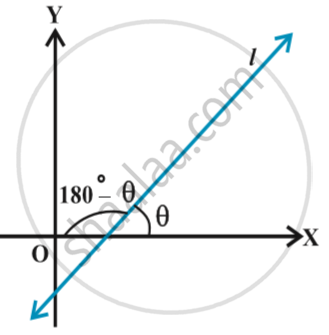
If θ is the inclination of a line l, then tan θ is called the slope or gradient of the line l. The slope of a line whose inclination is 90° is not defined. The slope of a line is denoted by m. Thus, m = tan θ, θ ≠ 90°
It may be observed that the slope of x-axis is zero and slope of y-axis is not defined.
Notes
Slope of a line when coordinates of any two points on the line are given:
To find the slope of a line in terms of the coordinates of two points on the line.
Let P`(x_1, y_1)` and Q`(x_2, y_2)` be two points on non-vertical line l whose inclination is θ. Obviously, x_1 ≠ x_2, otherwise the line will become perpendicular to x-axis and its slope will not be defined. The inclination of the line l may be acute or obtuse. Let us take these two cases.
Draw perpendicular QR to x-axis and PM perpendicular to RQ as shown in
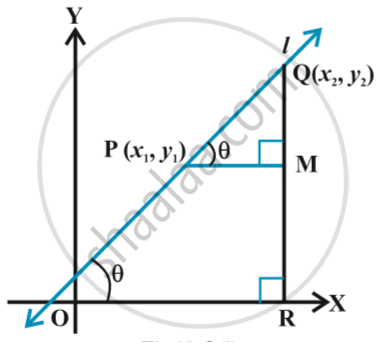
Case 1 : When angle θ is acute:
∠MPQ = θ . ... (1)
Therefore, slope of line l = m = tan θ.
But in triangle MPQ, we have tan `theta = (MQ)/(MP) `= `(y_2 -y_1)/(x_2 - x_1)` ....(2)
From equations (1) and (2), we have
m = `(y_2-y_1)/(x_2 -x_1)`
Case 2: When angle θ is obtuse:
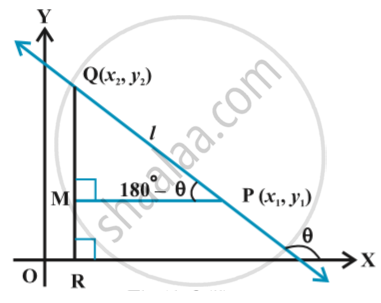
we have ∠MPQ = 180° – θ.
Therefore, θ = 180° – ∠MPQ.
Now, slope of the line l
m = tan θ
= tan ( 180° – ∠MPQ) = – tan ∠MPQ
=`(-(MQ)/(MP))` =` (-y_2-y_1)/(x_1-x_2) =(y_2-y_1)/(x_2-x_1)`
Consequently, we see that in both the cases the slope m of the line through the points
`(x_1, y_1)` and `(x_2, y_2)` is given by m =`(y_2-y_1)/(x_2-x_1)`.
Conditions for parallelism and perpendicularity of lines in terms of their slopes:
In a coordinate plane, suppose that non-vertical lines `l_1` and `l_2` have slopes `m_1` and `m_2`, respectively. Let their inclinations be α and β, respectively. If the line `l_1` is parallel to `l_2`.
then their inclinations are equal, i.e.,
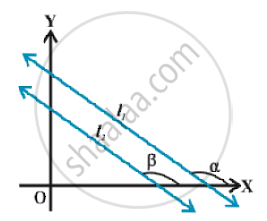
α = β, and hence, tan α = tan β
Therefore `m_1` = `m_2`, i.e., their slopes are equal.
Conversely, if the slope of two lines `l_1` and` l_2` is same, i.e.,
`m_1` =` m_2` Then tan α = tan β.
By the property of tangent function (between 0° and 180°), α = β. Therefore, the lines are parallel.
Hence, two non vertical lines `l_1` and `l_2` are parallel if and only if their slopes are equal.
Angle between two lines :
Let `L_1` and` L_2` be two non-vertical lines with slopes `m_1` and `m_2`, respectively. If `α_1` and `α_2` are the inclinations of lines `L_1` and `L_2`, respectively. Then
`m_1` = tan`α_1` and `m_2` = tan `α_2`.
two lines intersect each other, they make two pairs of vertically opposite angles such that sum of any two adjacent angles is 180°. Let θ and φ be the adjacent angles between the lines `L_1` and `L_2`. Then θ = `α_2` –` α_1` and `α_1`, `α_2` ≠ 90°.
Therefore tan θ = tan `(α_2` – `α_1`) = `(tanα_2 - tanα_1)/( 1+tanα_1tanα _2)` = `(m_2-m_1)/(1+m_1m_2)` (as 1 + m1m2 ≠ 0)
and φ = 180° – θ so that
tan φ = tan (180° – θ ) = – tan θ = `-(m_2-m_1)/(1+m_1m_2)` , as 1 + m1m2 ≠ 0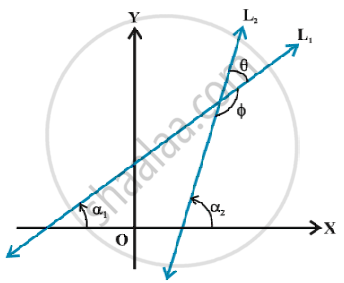
Collinearity of three points:
We know that slopes of two parallel lines are equal. If two lines having the same slope pass through a common point, then two lines will coincide. Hence, if A, B and C are three points in the XY-plane, then they will lie on a line, i.e., three points are collinear. if and only if slope of AB = slope of BC.

